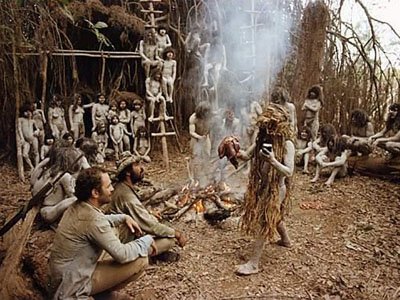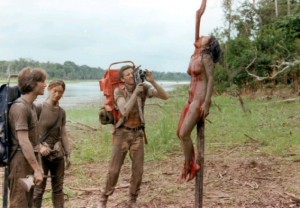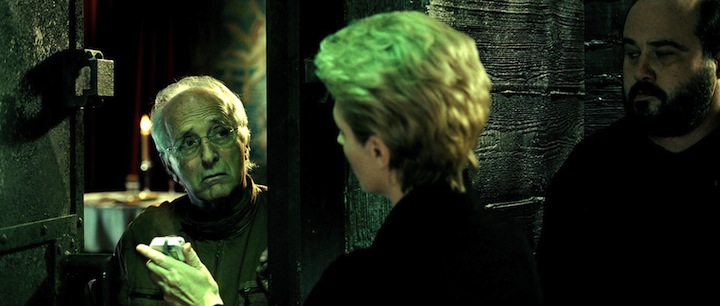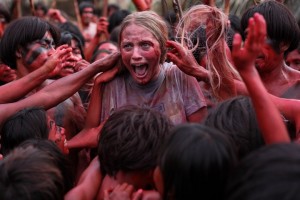Splatter Cinema presents CANNIBAL FEROX (1981); Dir. Umberto Lenzi; Starring John Morghen (Giovanni Lombardo Radice), Lorraine De Selle and Robert Kerman; Cinevision Screening Room; Saturday, August 15 @ 8:30 p.m.; IndieGoGo campaign w/ advance ticket sales end July 24; Admission at door is cash only; Trailer here.
By Aleck Bennett
Contributing WriterSplatter Cinema wants to bring you a rare chance to see Umberto Lenzi’s notorious CANNIBAL FEROX, aka MAKE THEM DIE SLOWLY on the big screen at Cinevision in all its 35mm glory. Incredibly they’ve scored a fully restored print from Grindhouse Releasing! But the catch is the rental and shipping is expensive, so they are dependent on an INDIEGOGO campaign with advance ticketing. If it doesn’t make its goal, this screening won’t happen. That would be a real shame because Splatter Cinema has really delved into the fetid jungle of grindhouse treasures to unearth this putrescent piece of gut-munching gore.
As I’ve mentioned here before, the horror genre is, in the eyes of many, disreputable. It’s not hard to see why—its primary purpose is to elicit something negative: fear. Comedy doesn’t get that reaction, because who doesn’t like to laugh? Action films promise thrills and excitement, which generally equals fun. Drama deals with serious topics and explores a wide range of emotion. But horror films conjure up some of our darkest emotions, and thus fall victim to the stigma of being “bad for you.” And some of horror’s subgenres get criticized more harshly than others. The slasher film, for instance, constantly comes under fire for celebrating slaughter. But no subgenre inspires the kind of wholesale, visceral revulsion than does the Italian cannibal film.
The whole craze started in 1972, when Umberto Lenzi helmed THE MAN FROM DEEP RIVER. Almost a beat-for-beat remake of 1970’s A MAN CALLED HORSE, Lenzi shifted that movie’s setting from the old west to the Thai rainforest and added a fascination with ritualistic acts, cannibalism, violence and animal cruelty (largely inspired by the worldwide success of exploitative pseudo-documentary Mondo movies such as MONDO CANE and AFRICA ADDIO). Its huge success in Italy and on the US grindhouse circuit led to the subgenre remaining successful for nearly two decades.
Generally speaking, the Italian cannibal film follows a particular pattern: it opens in the “civilized” world—typically New York, though this isn’t written in stone—and some incident occurs that pulls our protagonists into the (again, typically) Asian or South American jungle. There, they encounter some previously unknown, long-lost or much feared native tribe; witness or experience graphic violence, torture and/or rape; and then a bunch of people get eaten and the lone survivors return, battered but wiser. This plot plays out in Lenzi’s CANNIBAL FEROX, which ups the ante on all its predecessors by claiming to be the “most violent movie ever made.” It goes to such extremes that Italian exploitation stalwart John Morghen (aka Giovanni Lombardo Radice) expresses regret that he agreed to act in the movie to this day.
Now, there are a wide variety of reasons why CANNIBAL FEROX and its kin are viewed so negatively. To start off with, there’s the insinuation that entering into some foreign jungle will pretty much guarantee that you’ll become the next meal of some “savage tribe.” It might stop short of actual racism (and my use of “might” is mighty shaky), but short isn’t where most people would prefer to stop. Then there’s the issue of sexual violence and rape. Sexual violence in these movies is almost always a threat, whether it’s perpetuated against indigenous women by the outsiders or against female outsiders entering hostile territory. Sympathetic critics have defended both elements on the grounds that many of the Italian cannibal films are explicitly anti-colonialist in tone and critical of Western capitalism. The conquering white heroes invade a remote locale, rape its women and kill its men, and are dealt retribution in kind. It’s not particularly subtle, but then, neither are these films when it comes to anything else. They’re blunt instruments, the argument goes, meant to shock a complacent audience into examining itself and the violence inherent in the system.
And then there’s the actual animal cruelty depicted in these movies. For some reason, this is a longstanding element of the subgenre, and is the main focus of most people’s revulsion. Defenders of the cannibal genre argue that the presence of actual animal cruelty works as a technique because it causes you to question the reality of what you’re witnessing—if that is real, what else is? Others argue that some of the depictions reflect actual practices of the people populating the film, so it’s an introduction of documentary realism into a fictional framework. Still others argue that these elements are present in any number of critically celebrated films—from Coppola’s APOCALYPSE NOW and Cimino’s HEAVEN’S GATE to Tarkovsky’s ANDREI RUBLEV and Godard’s WEEK-END—and that singling out these films amounts to bigotry against the horror genre (“sure, I’ll let Coppola show a water buffalo being slaughtered because that’s art, but all horror is pretty much crap, so this cannibal movie is fair game”). All of which are salient points, to which I’ll add that the raison d’être of horror films—to evoke fear and revulsion—draws more attention to these acts than in other, more mainstream films. There’s no shift in tone to relieve the audience. Not that it makes the viewing any easier.
The genre reached what many consider its apex in 1980-81. Ruggero Deodato’s landmark 1980 film CANNIBAL HOLOCAUST touched on all of these elements and not only set aim at the horrors of colonialism, but turned its sights on the fact that an audience even existed to relish in the horrors he was putting on screen. As with Michael Haneke’s FUNNY GAMES, the viewer is made implicit in the crimes depicted as he or she watches. In making HOLOCAUST, Deodato seemed to be saying, “look upon the disgusting nature of this genre’s demands and know that they exist because you fools pay money to see them!”
Then came 1981’s CANNIBAL FEROX, released in the States as MAKE THEM DIE SLOWLY. So uncompromising that its marketing brags about having been banned in 31 countries, the movie sees Lenzi largely eschewing the postmodern moralizing of Deodato (while still picking up on the evils of colonialism and Western capitalism) and going straight for the jugular. It’s brutal, it’s ugly, and it represents one of the twin peaks of Italian cannibal cinema. Lenzi is an accomplished filmmaker and knows precisely how to push buttons and fills his movie with energy to spare. That it’s as well-made as it is only makes the bludgeoning savagery of the film that much more affecting. If it were truly a bad movie, then no amount of outrage would sustain the attention paid to the film over the years. I mean, nobody’s talking about Bruno Mattei’s MONDO CANNIBALE, which sports many of the same superficial elements (heck, it’s basically a remake of CANNIBAL HOLOCAUST) and it’s only 12 years old. No, CANNIBAL FEROX is a quantifiably good movie—well-paced, intelligently structured, and uniformly follows through on its line of reasoning to an inevitably downbeat conclusion (it’s always hard to judge the acting, because most Italian films were shot without sound and dubbed after the fact even in their home countries, but what is here is perfectly acceptable). It just may be completely reprehensible, depending on your point of view. To paraphrase Walter Sobchak in THE BIG LEBOWSKI, say what you want about the merits of CANNIBAL FEROX, Dude, but at least it’s got an ethos.
But at any rate, it’s a film that demands to be seen, experienced and then talked about. See it with your friends and debate the various controversial aspects of the movie afterward. No matter where you stand on the appropriate nature of the vile events that are depicted in the movie and the philosophical reasoning behind how they’re depicted…well…
It’s definitely something to chew on.
Aleck Bennett is a writer, blogger, pug warden, pop culture enthusiast, raconteur and bon vivant from the greater Atlanta area. Visit his blog at doctorsardonicus.wordpress.com.
Splatter Cinema Brings Italian Cannibal Mania in the Amazonian Jungle to the Cinevision Screening Room With CANNIBAL FEROX!
Posted on: Jul 17th, 2015 By: Anya99CINEMA ATLRETRO MACABRE #1: Of Cannibals and Chocolate: A Short Chat with Ruggero Deodato
Posted on: Jan 19th, 2014 By: Anya99Since Atlanta has become such a classic monster movie kind of city, ATLRetro presents the first in an ongoing new feature, CINEMA ATLRETRO MACABRE, featuring exclusive interviews with the masters and mistress of 20th century horror films. Our intrepid Retro Reviewer Andrew Kemp caught up with Ruggero Deodato, director of CANNIBAL HOLOCAUST (1980), last fall at the Twisted Fears convention. A special thanks also goes to Sandra Despirt, who translated the taped interview from Italian into English. Watch for our next interview with Barbara Steele soon.
By Andrew Kemp
Contributing Writer
We’re done talking, but the elderly gentleman holds me up for a second. He smiles and palms me a tiny wrapped piece of candy. He has, I swear, an actual twinkle in his eye. The gesture reminds me of something a movie grandpa might do, and the man—warm sweater, round glasses and with one last tuft of unruly white hair atop his head—certainly fits the role. I half-expect to find a golden Werther’s Original in my hand, but it turns out to be a fun-sized Milky Way. It’s not what I expect, but I can’t stop smiling at the thought that Ruggero Deodato just handed me a little morsel of something to eat.
Moments earlier that kindly old man, speaking to me in Italian with a translator, expressed bewilderment at his place in cinema infamy. “What I find incredible is that when I ask young people what they find more disturbing—my movie, CANNIBAL HOLOCAUST or the film of the real beheading of an American in Iraq—and they reply CANNIBAL HOLOCAUST,” he says. “Incredible, very disturbing.” Over 30 years after Deodato’s cannibal opus, the director still appears surprised at the power of what he made, even though he remains to this day one of the few film directors forced to produce his actors in the flesh simply to prove to authorities that they were still alive. Clearly, there’s just something about his film that digs beneath the skin.
CANNIBAL HOLOCAUST (1980) is one of cinema’s great provocations. A late entry into the brief Italian subgenre of cannibal movies, the film is alternately credited with canonizing the genre or destroying it, or sometimes both in the same breath. The film concerns a documentary crew that traipses into the Amazon to acquire rare footage of a savage, stone-age tribe of locals who may or may not engage in cannibalism. The title, I guess, is a spoiler. Suffice to say that no good comes to the crew, or to pretty much anyone else, including some unfortunate animals butchered on camera. Unlike the crew “deaths” that fooled the Italian courts, the animal torture is regrettably unsimulated. In the past, Deodato has claimed he was only filming a fact of daily life for the local tribes, that animals were routinely slaughtered in such a way for food and materials, not simply for his cameras. (A similar argument has always been made by Francis Ford Coppola about the bull death that closes APOCALYPSE NOW [1979]). Still, if you plan to see the film, consider the state of your stomach.
Central to the movie’s ability to unsettle is the way Deodato frames the movie as a documentary and shoots it accordingly. Today, we know what that should look like, but nothing else quite like CANNIBAL HOLOCAUST existed at the time. Already established in cannibal cred after his 1977 LAST CANNIBAL WORLD [aka JUNGLE HOLOCAUST], Deodato found inspiration for his new technique much closer to home. “I had already made the film LAST CANNIBAL WORLD, which was a big success, especially in Japan. I ultimately decided to make CANNIBAL HOLOCAUST when terrorism [the Red Brigades] was almost a daily occurrence in Italy and my 7-year -old son asked me why there were so many horrific images on TV, casualties of these acts of terrorism. I thought to myself, hey, why is it that journalists can get away with it and I can’t? If I make a film, they cut it, so I decided to make this movie as a statement against the journalists and censorship.”
Although Italian media may have been the inspiration, Deodato’s film had a global impact because it tapped into the rise of media violence being beamed into televisions everywhere, including those seen in American living rooms every night during the Vietnam War, still a fresh wound in 1980. The brutality and realism of Deodato’s images rankled the public. It felt real, with none of those distancing effects that make movies so much fun to watch. A cult classic was born. CANNIBAL HOLOCAUST became so notorious that other directors had difficulty launching their own cannibal productions, and the bubble quickly burst. Deodato’s was a tough act to follow.
In recent years, Deodato is seen less as a rebel and more as a horror pioneer. The journalistic style Deodato developed in 1980 is today called by another name: found footage. Both fans and critics of the now-ubiquitous genre usually point to THE BLAIR WITCH PROJECT (1999) as the movie that brought shaky cameras and screaming amateur actors into the mainstream, but it’s hard to watch those mapless teens die in the Massachusetts woods, or to remember the internet buzz the accompanied the film, without noting that Deodato got there almost 20 years earlier. Don’t expect Deodato to be proud of all of his misbegotten children. “Unfortunately my idea has ruined movie-making to some extent because there are those that think all they need to have is a small camera and [to] start shooting without consideration for technique or storyline development.”
“When I see films that have truly been inspired by my CANNIBAL HOLOCAUST, I’m very happy, but not when they start putting in zombies, aliens and vampires,” he adds. “I hate that.”
Eli Roth is one Deodato admirer who not only shares the director’s taste for horror realism but also prefers to populate his pictures with sadistic human monsters rather than ghosts and ghoulies. After breaking out with the disease gorefest CABIN FEVER (2002), Roth became a spiritual successor to Deodato with his HOSTEL series, replacing clueless journalists with clueless American teens whose condescension to Europe and lust for booze and sex make them prey for sinister millionaires willing to pay big bucks to kill. Roth wears his influences on his sleeve, adding a wink to this in HOSTEL PART II (2007) by casting Deodato as a cultured cannibal in one of the film’s more memorable gross-outs. Roth’s latest effort, THE GREEN INFERNO (2013), takes another step in Deodato’s direction by reigniting the cannibal drama. In Roth’s film, again it’s the naïve outsiders who are torn apart by the natives they were hoping to protect. “Thirty-three years have passed and I’m still being imitated,” Deodato says. “Eli Roth is a friend of mine so at the end of his movie he did an homage to me by saying in the credits – To Ruggero.”
The warmth that Deodato has for Roth doesn’t extend much further, it seems. I asked him about the current state of horror, how nobody seems to be terrorizing and disturbing audiences quite the way he did. “LAST CANNIBAL WORLD was filmed in the black jungle of Malaysia,” he notes. “For CANNIBAL HOLOCAUST, I was filming in the middle of the Amazon with indigenous tribes. Back in those days, people still didn’t know about a lot of things so when you came across a tribe in the middle of the jungle that was something. Now people travel everywhere. People were more easily shocked. It is much more difficult to do so now.”
Later, sitting on a panel with other Italian horror cinema legends Lamberto Bava and Barbara Steele, Deodato reminds me once more of a kindly old gentleman. When asked about horror cinema, he confesses that he doesn’t much like the genre anymore, noting his preference for dramas and romances. I think back on the story of the “murdered” actors he had to produce in court, and recall that even after the actors appeared, not all of the charges were dropped. Such was the impact of Deodato’s gore that to be fully cleared, the director first had to first demonstrate to court officials exactly how he had accomplished a signature, grotesque impalement with special effects. I think the prosecutor in question just wanted to get that particularly nasty bit out of his head.
Andrew Kemp is a screenwriter and game designer who started talking about movies in 1984 and got stuck that way. He can be seen around town wherever there are movies, cheap beer and little else.





